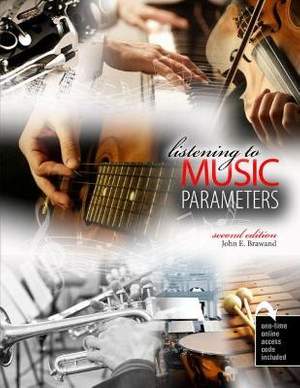
Listening to Music Parameters
- Author: Brawand, John E.
Book
$264.00Out of stock at the UK distributor
Contents
- Foreword to Students and Instructors
- UNIT ONE ELEMENTS OF MUSIC I
- Chapter 1 America's Own Musical Styles: Jazz
- Chapter 2 Musical and Grammatical Goals of Writing
- Chapter 3 Three Basic Music Parameters-a. Rhythm
- Chapter 4 Three Basic Music Parameters-b. Melody
- Chapter 5 Three Basic Music Parameters-c. Harmony
- Chapter 6 Texture
- Chapter 7 Dynamics
- Chapter 8 Keyboard Half Steps, Whole Steps, and Scales
- Chapter 9 Form
- Chapter 10 America's Own Musical Styles: CountryUNIT TWO ELEMENTS OF MUSIC II
- Chapter 11 Timbre Part I: Woodwind and Brass Orchestral Colors
- Chapter 12 Timbre Part II: Percussion and String Orchestral Colors
- Chapter 13 Variety in Tempo and Beat
- Chapter 14 Timbre Part III: Vocal Ranges and Choral Colors
- Chapter 15 Timbre Part IV: Keyboard and Electronic Colors
- Chapter 16 Parameters, an Endless List
- Chapter 17 Style Periods
- Chapter 18 Principles and Methodologies in Writing
- Chapter 19 Writing Concert Reports
- Chapter 20 America's Own Musical Styles: Rock
- Chapter 21 Film and Light Concert MusicUNIT THREE MIDDLE AGES THROUGH CLASSICAL: 450-1820
- Chapter 22 Middle Ages
- Chapter 23 Monophonic Song
- Chapter 24 Renaissance
- Chapter 25 From Renaissance to Baroque
- Chapter 26 The Middle Baroque: Dance, Theatre, and String Music
- Chapter 27 Johann Sebastian Bach and Counterpoint
- Chapter 28 George Frideric Handel and the English Oratorio
- Chapter 29 Pre-Classical Music, 1730-1760
- Chapter 30 Franz Joseph Haydn, New Genres: Symphony and String Quartet
- Chapter 31 Wolfgang Amadeus Mozart, Prolifi c Prodigy
- Chapter 32 Beethoven Beginnings: Imitation and Independence PeriodsUNIT FOUR ROMANTICISM PART I
- Chapter 33 Beethoven New Genres and Forms: Introspection Period
- Chapter 34 Schubert and the Art Song
- Chapter 35 Weber Opera and Orchestral Works
- Chapter 36 Schumann Character Piece and Music Criticism
- Chapter 37 Berlioz and the Program Symphony
- Chapter 38 Paganini and the Role of Virtuosity
- Chapter 39 Liszt and the Symphonic Poem
- Chapter 40 Wagner and the Music Drama
- Chapter 41 Donizetti to Verdi: Romantic Opera
- Chapter 42 Chopin and Piano Miniatures
- Chapter 43 Mendelssohn and Brahms: Innovations in Old Genres
- Chapter 44 Puccini and the Italian Pinnacle of Verismo Opera
- Chapter 45 Johann Strauss Jr. and the Viennese Waltz, LandlerUNIT FIVE ROMANTICISM PART II THROUGH TWENTIETH CENTURY AND BEYOND
- Chapter 46 Smetana and Dvo rak, Nationalism in Orchestral Genres
- Chapter 47 The "Mighty Five" Russian Nationalism in Opera and Orchestral Genres
- Chapter 48 Tchaikovsky: Tradition, Ballets, and Suites
- Chapter 49 Saint-Saens and the French Tradition
- Chapter 50 Scandinavian Pockets of Nationalism: Grieg and Sibelius
- Chapter 51 Rachmaninoff and Russian Romanticism in Traditional Genres
- Chapter 52 Mahler and Song, Song Cycle, and Symphony
- Chapter 53 Richard Strauss and Symphonic Poem Virtuosity
- Chapter 54 Debussy and Ravel, French Avant-Garde Impressionism
- Chapter 55 Arnold Schoenberg and the Second Viennese School
- Chapter 56 Stravinsky and the Primitivism Ballets
- Chapter 57 Prokofiev and Shostakovich: Russian Avant-Garde and the Soviet Influence
- Chapter 58 New Directions in Twentieth-Century America and EuropeWorks Cited
- Postlude
- Dates
- Glossary
- Index


